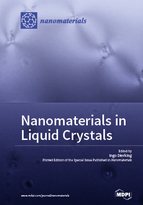Nanomaterials in Liquid Crystals
A special issue of Nanomaterials (ISSN 2079-4991).
Deadline for manuscript submissions: closed (31 January 2018) | Viewed by 81154
Special Issue Editor
Interests: liquid crystals; chiral liquid crystals; ferroelectric liquid crystals; polymer stabilized liquid crystals; nanoparticles in anisotropic fluids; liquid crystal-nanotube dispersions; defects and defect dynamics; phase ordering in soft matter; fractal structures
Special Issues, Collections and Topics in MDPI journals
Special Issue Information
Dear Colleagues,
This Special Issue of Nanomaterials covers the formulation, properties, theoretical aspects and applications of nanoparticles and nanostructures, dispersed in liquid crystal phases of the thermotropic and the lyotropic type, including lyotropic liquid crystal phase formation by dispersing nanomaterials in isotropic carrier fluids. The systems of nanomaterials in liquid crystals have attracted increasing interest over the last few years, due to the possibility of adding functionality to liquid crystals through properties of the dispersed particles, as well as through exploiting the self-organization of liquid crystals to form ordered structures of nanomaterials. This multidisciplinary field of research has led to a wealth of novel systems in soft condensed matter, and promises new applications in the areas of displays, optical elements, meta-materials, sensors, drug delivery, and the like.
Submission of manuscripts is invited for example, but not exclusively, on the following topic areas:
Methods of nanoparticle dispersion in anisotropic fluids
Synthesis of nanoparticle containing mesogens
Phases, chemical and physical properties of liquid crystal-nanomaterial dispersions
Microparticles and arrays of particles in liquid crystals
Nanotubes in liquid crystals
Graphene and related two-dimensional materials in liquid crystals
Clay doped thermotropic and inorganic liquid crystals
Lyotropic behaviour from colloidal particles in polar fluids
Computer simulations and theory
Applications
This list is certainly not conclusive and can be expanded. Original research papers and review articles will be considered. For reviews, please contact the Guest Editor, Dr. Ingo Dierking ([email protected]), in advance to discuss the details of the suggested contribution, in order to avoid a too extensive overlap of covered material with that of potential other authors.
Dr. Ingo Dierking
Guest Editor
Manuscript Submission Information
Manuscripts should be submitted online at www.mdpi.com by registering and logging in to this website. Once you are registered, click here to go to the submission form. Manuscripts can be submitted until the deadline. All submissions that pass pre-check are peer-reviewed. Accepted papers will be published continuously in the journal (as soon as accepted) and will be listed together on the special issue website. Research articles, review articles as well as short communications are invited. For planned papers, a title and short abstract (about 100 words) can be sent to the Editorial Office for announcement on this website.
Submitted manuscripts should not have been published previously, nor be under consideration for publication elsewhere (except conference proceedings papers). All manuscripts are thoroughly refereed through a single-blind peer-review process. A guide for authors and other relevant information for submission of manuscripts is available on the Instructions for Authors page. Nanomaterials is an international peer-reviewed open access semimonthly journal published by MDPI.
Please visit the Instructions for Authors page before submitting a manuscript. The Article Processing Charge (APC) for publication in this open access journal is 2900 CHF (Swiss Francs). Submitted papers should be well formatted and use good English. Authors may use MDPI's English editing service prior to publication or during author revisions.
Keywords
liquid crystal
ordered fluid
self-organisation
functional mesogen
magnetic and ferroelectric nanoparticles
nanotubes
graphene and other two-dimensional nanomaterials
biological nanostructures
colloidal dopants







